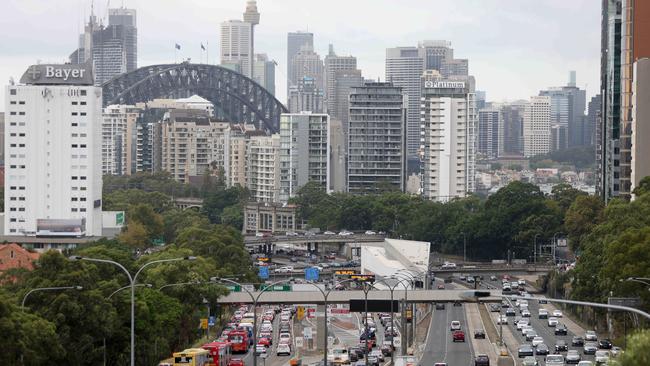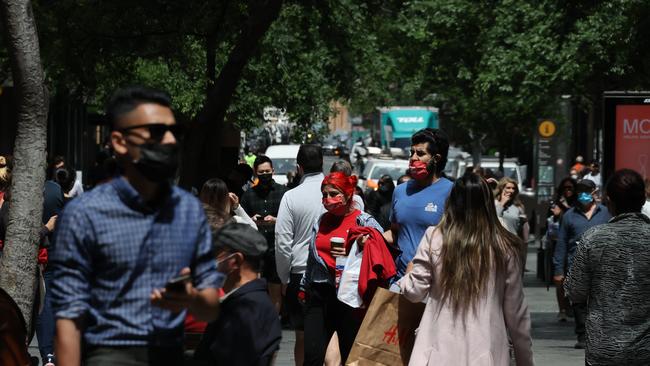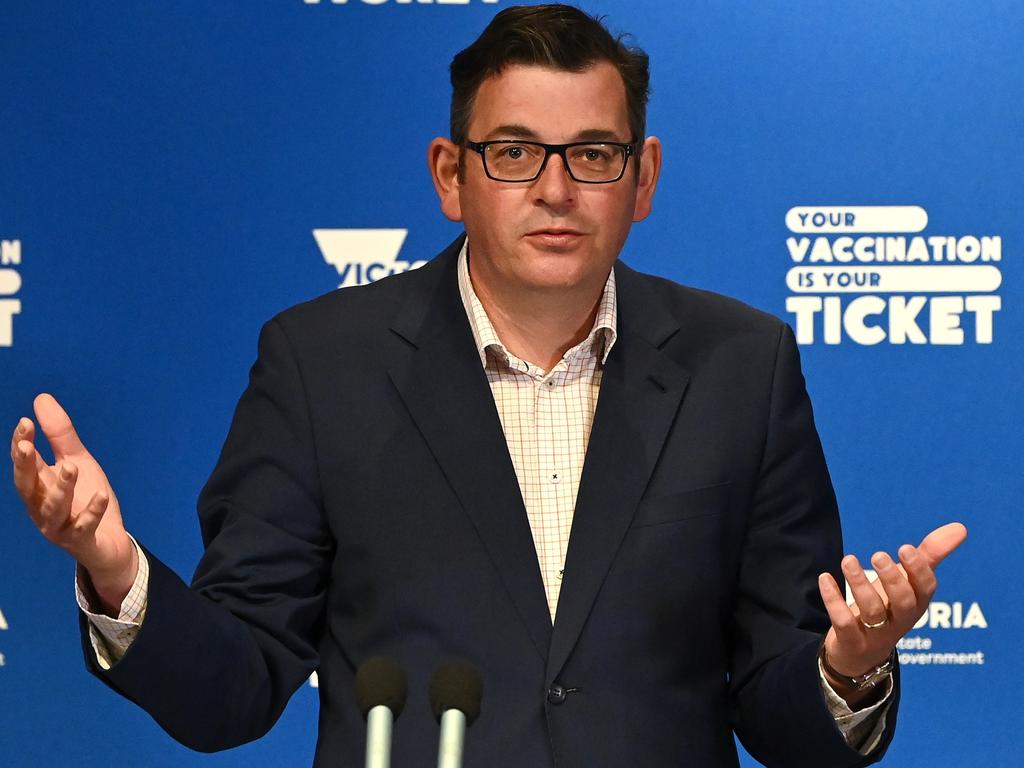As borders reopen, governments and business are seeking tourists, students and skilled workers
Ready or not, the way is being prepared for a post-pandemic migration surge.

Why all the fuss on net zero? Ahead of next weekend’s Glasgow climate summit, everyone is looking 30 years down the track at our emissions target. But last year we reached a couple of near-zero population milestones that will have far-reaching social and economic consequences.
After years of averaging 240,000 in so-called net overseas migration, prompting the Big Australia branding, last year we recorded a net outflow of migrants. In the year to March, the latest figures available, our population was static as the rush by foreign workers and students for the departure gate almost wiped out the natural increase (births minus deaths).
At 0.1 per cent, we posted our weakest population growth in over a century, compared with an annual average rate of 1.4 per cent over the past 40 years. Treasury’s Centre for Population expects NOM outflows to total 174,000 in the two financial years most affected by the pandemic and, coupled with falling fertility, our population will be permanently smaller. Fitch Ratings said this “shock” to immigration had slashed Australia’s growth potential from the annual 2.9 per cent it had averaged for two decades before the pandemic to just 2.1 per cent.
Pushing migration would have been pointless during successive waves of Covid-19 when borders were closed. But with the easing of travel, work and social restrictions due to rising rates of inoculation against the virus, the boosters are coming out in strong voice.
Dominic Perrottet declared he “believes in a big NSW”. The state sucks in migrants but also loses people to other parts of the nation because of its high housing costs. NSW Treasury sees migration as a way to slow the ageing process and reduce the age-dependency ratio, boost productivity and skills, and fortify its budget.

When Perrottet succeeded Gladys Berejiklian this month, bureaucrats reportedly provided an incoming brief urging him to take national leadership on migration, while calling for a doubling of pre-pandemic levels over the next five years.
This week the Australian Chamber of Commerce and Industry called for a doubling in annual skilled migration to 200,000 over the next five years to prevent a “skills crunch”. Innes Willox, chief of national employer association Ai Group, followed with a plea for a restoration in the annual permanent migration ceiling to 190,000 (it was cut to 160,000 just before the pandemic hit).
Scott Morrison and his ministers have also been spruiking the boon from open borders, with the imminent return of tourists and students. Immigration Minister Alex Hawke believes skilled migration “will come back very quickly because Australia is a very attractive destination, and the government will ensure people are incentivised to come back”.
The Big Australia express is leaving the station, destined to reach the speeds of the past decade where it accounted for 60 per cent of population growth. The hiatus gave policymakers a chance to plan for the coming journey; to work out what was needed to accommodate the extra people, address emerging skills gaps; and to find ways to sustain industries that had become over-reliant on foreigners, such as education.
But not everyone is on board. Big? “Non-elite” Australia, as some social
scientists contend, says no to more people. According to The Australian Population Research Institute’s report, “Politics and the population question during the pandemic”, published this month, voters were asked if they wanted to see immigration levels restored to around 240,000 a year or higher, or whether they would prefer lower levels, including a balance of inward and outward movements (that is, nil net migration).
TAPRI’s survey, taken in July, found only 19 per cent of voters support a return to the pre-pandemic level. The rest want much less, including 28 per cent who prefer nil net migration. TAPRI principals Bob Birrell and Katharine Betts argue the advocates of Big Australia have had ample time to put their case for a return to elevated levels, and they’ve failed.
“There has been a distinct hardening of attitudes towards immigration,” Birrell and Betts write.
“Before the pandemic there was a rough balance between the share of voters wanting the current numbers to remain the same or to increase and those wanting them to decrease.” In the TAPRI survey, 76 per cent of Coalition supporters wanted migration below pre-pandemic levels, compared with 67 per cent of Labor partisans and 47 per cent of Greens voters.
Is there a wedge here for Anthony Albanese to exploit? Maybe, say Birrell and Betts, who contend Labor has a new stance on immigration and note its special platform conference in March did not endorse a Big Australia target.
“On the contrary, (Labor) puts much more emphasis on safeguarding the interests of Australian workers from migrant competition, especially that coming from migrants holding temporary work visas,” they write.
Last year, Kristina Keneally, Labor’s spokeswoman on immigration and citizenship, argued for an “Australia First” hiring policy in the recovery from the pandemic. Birrell and Betts argue that in a tight federal election, where there are few policy differences between the major parties, “Labor might be tempted to make its differences on immigration policy with the Coalition an election issue. The large share of Coalition voters who do not support the Coalition’s high migration commitment might be a tempting target”.
As yet, no one in power federally is aggressively frontrunning on higher migration, just stroking the bellies of hungry growth lobbies. The skills issue is complex. Reserve Bank governor Philip Lowe said high migration has been a factor in secular wage stagnation and has seen employers investing less in skilling local workers. Willox maintains employers are willing to train workers “but progress is slow and there are very long lead times”.

But migration alone won’t be able to fill a forecast 105,000 shortfall in jobs Infrastructure Australia has said could derail the $218bn in public investment over the next five years, with gaps most likely to appear in Victoria, Tasmania and Queensland. IA noted importing workers won’t be able to meet the demand for civil engineers, particularly in the face of global competition for talent, as countries leverage infrastructure as part of post-Covid stimulus measures.
EY has developed a labour market model that pinpoints growing rigidities in our system, from occupational and geographic mobility, to training and education. Its economists argue that getting migration policy settings right has the potential to dramatically shorten the length of the nation’s skill shortage. But it will also require an ambitious lift in migration to make up for the Covid shortfall, as well as collaboration with industry to identify the right skills that we’re seeking to attract.
Treasury analysis suggests the pandemic has produced a shortfall of 830,000 people by 2024. June’s Intergenerational Report posits a couple of long-term trends; our population growth rate will recover to 1.3 per cent over the next two years, but then is gradually projected to slide to 0.8 per cent by 2060-61, due to a fall in fertility and ageing.
In four decades, with a projected population of 38.8 million, migration of 235,000 a year will account for three-quarters of annual population growth. The boosters, however, are hoping the NOM is maintained at a steady rate over coming decades of 0.9 per cent, meaning the inflow would be as much as 400,000 a year.
Josh Frydenberg is, at heart, a Big Australia proponent. It goes with the portfolio, especially on his side of politics. This week the Treasurer said he was thinking about the issues of ageing and structural decline in our fertility “in terms of the size and composition of our migration program”.
Skilled migrants tend to be younger and of working age, so they can quickly plug holes in the population profile, boosting productivity and participation. “Aside from age and skill, other migrant characteristics such as English-speaking ability, complementarity with the existing labour force, and entrepreneurship have also been associated with higher economic and fiscal contributions,” Treasury said in the IGR.
Yet in considering migrants’ fiscal impact on the federal budget – adding taxes paid and subtracting spending on their health and aged care, transfer payments and education – Treasury finds only the skilled primary visa holder is a net-plus. A skilled migrant’s accompanying partner and dependants, family visa holders, and humanitarian migrants are all a drain on the budget (this does not take account of state and local budgets). So, too, for that matter are members of the general population, who receive more in federal benefits than they pay in tax.
Of course, migrants bring more to this nation – cultural diversity and innovation, for starters – than this crude accounting. Plus, we have international obligations to meet. But, as Treasury says, “migration should be kept at or below the capacity of the destination city or region to absorb new migrants, taking into account impacts on incumbent populations”.
Big Australia sucks up resources: land, road, rail and public services. So governments need to plan and provide the infrastructure – and be open about their migration programs. The Centre for Population will release its second population statement in December to guide governments. The pause should be a time to “build it before they come”, target the permanent migrants we need most, and for politicians and officials to explain to a sceptical public why they are again stoking the population engine.







To join the conversation, please log in. Don't have an account? Register
Join the conversation, you are commenting as Logout